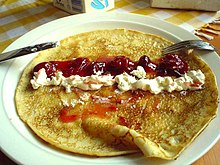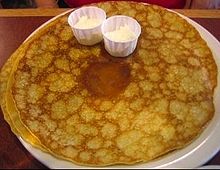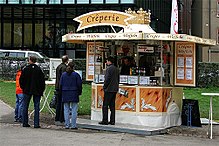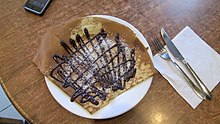مستخدم:Nazem Saeed Isaac/لفيفة
| اسم آخر | كغيب أو كريب |
|---|---|
| المنشأ | |
| النوع | |
| حرارة التقديم | دافئة أو لا |
| المكونات الرئيسية | دقيق القمح أو دقيق الحنطة السوداء، حليب، بيض |

كريب أو كغيب أو لفيفة (بالفرنسية: Crêpe وتنطق /kreɪp/ ⓘ[1] أو /krɛp/، نطق فرنسي: [kʁɛp] (![]() أنصت)) هي نوع من المعجنات الرفيعة جدا، تصنع عادة من دقيق القمح (crêpes de froment) أو دقيق الحنطة السوداء (الكعك). تنتمي اللفائف إلى الفئة العامة لتيغانيتاي اليونان القديمة، من تيغانوس اليونانية (τίγανος)، والتي تعني "المقلاة"، والتي تترجم للإنگليزية حرفيًا بان كيك[2]. المصطلح الفرنسي، كغيب، مستمد من الكلمة اللاتينية crispa، والتي تعني تيغنيتاي مطوية/ملفوفة. بينما اللفائف غالبا ما ترتبط ببريتاني، وهي منطقة تقع في شمال غرب فرنسا، استهلاك اللفائف واسع الانتشار في فرنسا، بلجيكا، كندا، والعديد من أجزاء أورپا، شمال أفريقيا، والمخروط الجنوبي لأميركا الجنوبية. تقدم اللفائف مع مجموعة متنوعة من الحشوات، من الأبسط بالسكر فقط وحتى الكريب سوزيت أو مقبلات العكك.
أنصت)) هي نوع من المعجنات الرفيعة جدا، تصنع عادة من دقيق القمح (crêpes de froment) أو دقيق الحنطة السوداء (الكعك). تنتمي اللفائف إلى الفئة العامة لتيغانيتاي اليونان القديمة، من تيغانوس اليونانية (τίγανος)، والتي تعني "المقلاة"، والتي تترجم للإنگليزية حرفيًا بان كيك[2]. المصطلح الفرنسي، كغيب، مستمد من الكلمة اللاتينية crispa، والتي تعني تيغنيتاي مطوية/ملفوفة. بينما اللفائف غالبا ما ترتبط ببريتاني، وهي منطقة تقع في شمال غرب فرنسا، استهلاك اللفائف واسع الانتشار في فرنسا، بلجيكا، كندا، والعديد من أجزاء أورپا، شمال أفريقيا، والمخروط الجنوبي لأميركا الجنوبية. تقدم اللفائف مع مجموعة متنوعة من الحشوات، من الأبسط بالسكر فقط وحتى الكريب سوزيت أو مقبلات العكك.
الإعداد
تصنع اللفائف بسكب خليط القمح في مقلاة أو لوحة مسطحة دائرية ساخنة، غالبا مع مقدار ضئيل من الزبدة أو زيت نباتي على سطح المقلاة. وينتشر الخليط بالتساوي على سطح الطهي من المقلاة أو اللوحة إما عن طريق إمالة المقلاة أو عن طريق توزيع الخليط بملعقة مسطحة أو مجرفة.[3][4] يمكن أن تستغرق عملية الطهي من 30 إلى 60 ثانية حتى يبدو الجزء المطهي كسطح القمر، ثم تقلب لتسوية الجزء الآخر؛ يمكن للمرء أن يقلبها في الهواء بأرجحة المقلاة.
لأن المظهر الخارجي للفيفة أكثر جاذبية، فإنها لا تقدم عادة مفتوحة.[5]
اللفائف المحلاة تصنع عموما من دقيق القمح بينما اللفائف المالحة تصنع بأنواع دقيق غير القمح مثل الحنطة السوداء. يمكن للخليط أن يتكون أيضًا من مكونات أخرى بسيطة، مثل: الزبدة، الحليب، الماء، البيض، الدقيق، الملح، والسكر.[6]
الحشوات المالحة الشائعة للفائف والتي تقدم على وجبات الغداء أو العشاء هي الجبن، الهام، والبيض، يخنة راتاتوي، عيش الغراب، الخرشوف (في بعض المناطق)، ومنتجات اللحوم المتنوعة. تضاف الحشوات عادة إلى مركز اللفيفة وتقدم مع حواف مطوية جزئيا فوق المركز. يمكن أيضا أن يضاف إليها أنواع عديدة من المأكولات كالدجاج و البشاميل، الخضروات، السلمون المدخّن وغيرها.
عندما تكون محلاة، يمكن أن تؤكل كجزء من الإفطار أو كحلوى. يمكن أن تحشى وأن يوضع فوقها طبقات علوية محلاة متنوعة، وغالبا ما تحتوي على نوتيلا سبريد، مربى، سكر (حبيبات أو مسحوق)، عسل، شراب القيقب، عصير فاكهة ذهبي، عصير الليمون، قشدة مخفوقة، مربى بدون سكر، كاسترد، وشرائح فواكه ناعمة أو مربى الفاكهة.
الأنواع واللفائف الخاصة

Crêpes are especially popular throughout France. The common ingredients include flour, eggs, milk, butter, and a pinch of salt. Crêpes are usually of two types: sweet crêpes (crêpes sucrées) made with wheat flour and slightly sweetened; and savoury galettes (crêpes salées) made with buckwheat flour and unsweetened. The name "galette" came from the French word galet ("pebble") since the first gallettes were made on a large pebble heated in a fire. Batter made from buckwheat flour is gluten-free, which makes it possible for people who have a gluten allergy or intolerance to eat this type of crêpe. Mille crêpes is a French cake made of many crêpe layers. The word mille means "a thousand", implying the many layers of crêpe.[7] Another standard French and Belgian crêpe is the crêpe Suzette, a crêpe with lightly grated orange peel and liqueur (usually Grand Marnier) which is subsequently lit upon presentation.[8]
English pancakes are like wheat flour crêpes, and are served with golden syrup or lemon juice and sugar. Swedish pancakes, also called Nordic pancakes, are similar to the French crêpes. In some of the Nordic countries, they are served with jam or fruit, especially lingonberries (or the butter from that fruit) as a dessert with a variety of savory fillings. Traditional Swedish variations can be exotic. Beside the usual thin pancakes, called pannkakor in Swedish and räiskäle in Finnish, which resemble the French crêpes and, often served with whipped cream and jam, are traditionally eaten for lunch on Thursdays with pea soup, the Swedish cuisine (as well as the Finnish one) has plättar/lettu which resemble tiny English pancakes, and are fried several at a time in a special pan. Others resemble German pancakes but include fried pork in the batter (fläskpannkaka); these are baked in the oven. Potato pancakes called raggmunk contain shredded raw potato and may contain other vegetables (sometimes the pancake batter is omitted, producing rårakor). Raggmunk and rårakor are traditionally eaten with pork rinds and lingonberry jam. A special Swedish pancake is saffron pancake from Gotland, made with saffron and rice, baked in the oven. It is common to add lemon juice to the sugar for extra taste. The pancakes are often served after a soup. Another special "Swedish pancake" is the äggakaka (eggcake), also called skånsk äggakaka (scanian eggcake), it is almost like an ordinary Swedish pancake but it is a lot thicker and also a lot more difficult to make due to the risk of burning it. It is made in a frying pan and is about 1½ to 2 inches thick and is served with lingonberries and bacon. The Norwegian variety is commonly eaten for dinner, traditionally with bacon, jam (typically bilberry jam) or sugar.

The 49er flapjack is a sourdough crepe which is popular in the United States,[9] getting its name from the popularity of this style of pancake during the California Gold Rush. Because it is similar to a Swedish pancake the 49er is sometimes served with lingonberry sauce, although most often it is rolled up with butter and powdered sugar, or served open-faced and topped with maple syrup.
Cherry Kijafa Crêpes are also often common and are made with a traditional crêpe base, but filled with cherries simmered in a Kijafa wine sauce.[10]
Crêpe dentelle is a crispy biscuit made with a very thin layer of crêpe folded in a cigar shape and then baked. It is usually enjoyed with a hot drink during the goûter, in France.[11]
مطاعم اللفائف


A crêperie may be a takeaway restaurant or stall, serving crêpes as a form of fast food or street food, or may be a more formal sit-down restaurant or café.[12]
Crêperies are typical of Brittany in France; however, crêperies can be found throughout France and in many other countries.
Because a crêpe may be served as both a main meal or a dessert, crêperies may be quite diverse in their selection and may offer other baked goods such as baguettes. They may also serve coffee, tea, buttermilk, and cider (a popular drink to accompany crêpes).[13]
في البلاد الأخرى


In Norwegian, crêpes are called Pannekake, in most German regions Pfannkuchen. In Swedish, a crêpe is called pannkaka in southern regions while being called "plättar" in the north, in Danish, pandekager ("pancake"), in Finnish a crêpe is called either ohukainen or lettu or räiskäle, in Dutch it is a pannenkoek or flensje, and in Afrikaans a pannekoek, which is usually served with cinnamon sugar. In the Spanish regions of Galicia and Asturias, they are traditionally served at carnivals. In Galicia, they're called filloas, and may also be made with pork blood instead of milk. In Asturias, they are called fayueles or frixuelos, and in Turkey, "Akıtma".
In areas of central Europe, formerly belonging to the Austro-Hungarian empire, there is a thin pancake comparable to a crêpe that in Austro-Bavarian is called Palatschinken; in (بالمجرية: palacsinta); and in Bosnian, Serbian, Bulgarian, Macedonian, Montenegrin, Czech, Croatian, and (بالسلوفينية: palačinka); in (بالسلوفاكية: palacinka). In the Balkan region such as the countries of Albania, Bosnia, Croatia, Kosovo, Macedonia, Montenegro, and Serbia, palačinka or pallaçinka may be eaten with fruit jam, quark cheese, sugar, honey, or the hazelnut-chocolate cream Nutella, while there is also a breaded variant which is mostly filled with meat. Restaurants which are specialized in palačinci are called "Palačinkara" in the region. In Ashkenazi Jewish cuisine, there is a similar dish known as the blintz. The Oxford English Dictionary derives the German and Slavic words from the Hungarians palacsinta, which it derives from the Romanian plăcintă, which comes in turn from classical Latin placenta ("small flat cake"), even though the Romanian plăcintă is more similar to a pie, and the crêpes are actually called clătită.
Crêpes have also long been popular in Japan, with sweet and savoury varieties being sold at many small stands, usually called crêperies. In Argentina and Uruguay, they are called panqueques and are often eaten with dulce de leche. Various other French foods, such as crêpes, souffles, and quiche, have slowly made their way into North American cooking establishments.[14] Typically, these franchises stick to the traditional French method of making crêpes but they have also put their own spin on the crêpe with new types such as the hamburger and pizza crêpe. In Mexico, crêpes are known as crepas, and were introduced during the 19th century by the French [15][16] and are typically served either as a sweet dessert when filled with cajeta (similar to dulce de leche), or as a savoury dish when filled with Huitlacoche (corn smut), which is considered a delicacy.
اللفائف في الثقافة الأورپية
During Russian celebration of Maslenitsa (Russian Butter Week), one of the most popular foods is blini, or crepes. Since crepes are made from butter, eggs and milk, they are allowed to be consumed during the celebration by the Orthodox church. There are endless combinations to the recipes and the execution of crepes. White flour can be replaced with buckwheat flour and milk can be switched for kefir. Also different oils can be added or substituted. Blini are served stocked with a piece of butter and topped with caviar, cheese, meat, potatoes, mushrooms, honey, berry jam or often a dollop of sour cream. The dish is supposed to represent the sun, since the holiday is about the beginning of the spring.[17]
In addition to crêperies and crêpe franchises, there are crêpe manufacturers that use modern equipment to produce crêpes in bulk.

Dishes with similar appearance, taste and preparation methods exist in other parts of the world as well. In South India, a crêpe made of fermented rice batter is called a dosa, which often has savoury fillings. In Western India, a crepe made of gram flour is called Pudlaa/Poodla, with the batter consisting of vegetables and spices. Another variety is called patibola and is sweet in taste due to milk, jaggery or sugar. The injera of Ethiopian/Eritrean/Somali/Yemeni cuisine is often described as a thick crêpe. Also in Somalia, Malawaḥ (Somali: Malawax) is very similar to a crêpe. It is mostly eaten at breakfast.
The names for thin crêpes in other parts of Europe are:
- (بالتركية: krep, akıtma)
- (بالألمانية: Palatschinke)
- (بالقازاقية: құймақ) (quymaq)
- (بالألبانية: pallaçinka)
- (بالأستورية: frixuelo)
- (بالبوسنوية: palačinka)
- (بالبريتانية: krampouezh)
- (بالبلغارية: палачинка)
- (بالكورنية: krampoeth)
- (بالكرواتية: palačinka)
- (بالتشيكية: palačinka)
- (بالإستونية: pannkook, ülepannikook)
- (بالفاروية: pannukaka)
- (بالفنلندية: ohukainen, lätty, lettu or räiskäle)
- (بالغاليسية: filloas)
- (باليونانية: κρέπα (krépa))
- (بالمجرية: palacsinta)
- (بالآيسلندية: pönnukaka)
- (باللاتفية: pankūka)
- (بالليتوانية: lietiniai blynai)
- (بالبولندية: naleśniki)
- (بالبرتغالية: crepe)
- (بالرومانية: clătită)
- (بالروسية: блины) (bliny)
- (بالصربية: палачинка)
- (بالسلوفاكية: palacinka)
- (بالسلوفينية: palačinka)
- (بالإسبانية: crepes)
- (بالأوكرانية: млинці, налисники) (mlyntsi, nalysnyky)
- (بالويلزية: cramwyth)
في الثقافة
The crêpe was born as an accident, created by fourteen-year-old waiter Henri Charpentier in 1895 at the Maitre at Monte Carlo’s Café de Paris. He was preparing a dessert for the Prince of Wales and describes the creation of the desert in a published book about his life. He states that it was an accident that the pastry had burned and Charpentier tasted it hoping it would be good enough to serve, since there wasn't enough time to create a new dish. Charpentier describes the creation of the crêpe with, "Thus was born and baptized this confection, one taste of which, I really believe, would reform a cannibal into a civilized gentleman." It was served to the prince who enjoyed it so much that the following day he sent its creator a panama hat, a cane, and a jeweled ring.[18]
In France, crêpes are traditionally served on Candlemas (La Chandeleur), 2 February. This day was originally Virgin Mary's Blessing Day but became known in France as "Le Jour des Crêpes" (literally translated "The Day of the Crêpes", but sometimes given colloquially as "Avec Crêpe Day", "National Crêpe Day", or "day of the Crêpe "), referring to the tradition of offering crêpes. The belief was that if you could catch the crêpe with a frying pan after tossing it in the air with your right hand and holding a gold coin in your left hand, you would become rich that year.[19][20] The roundness, and golden color from being fried in butter, of the crêpe resembles the sun and its rays. This symbolism also applies to the coin held in the person's hand.[21]
انظر أيضا
- Bánh xèo
- Blintz
- Crêpe bretonne
- Crepe maker, crepe cooking device
- Dosa
- Galette, another kind of Breton pancake, also from Brittany, France
- Injera
- Jianbing, a traditional Chinese street food similar to crepe
- Kouign amann, another Breton delicacy
- Krampouz, crepe maker manufacturer, also from Brittany, France
- List of brunch foods
- List of pancakes
- Maslenitsa
- Memiljeon
- Palatschinken
- Pancake Day
- Popiah, Chinese roll wrapped in a thin crepe made by "wiping" dough on a hot plate
- Ploye, a buckwheat pancake originating from Acadian cuisine of Canada
- Poffertjes, small ball-shaped pancake, particularly popular in the Netherlands
- Roti prata
- Sope
- Swedish pancake
- Tava
المصادر
- 19. Life A La Henri – Being The Memories of Henri Charpentier, by Henri Charpentier and Boyden Sparkes, The Modern Library, New York, 2001 Paperback Edition. Originally published in 1934 by Simon & Schuster, Inc.
قالب:طعام الشارع
[[:تصنيف:بان كيك]][[:تصنيف:مطبخ بلجيكي]][[:تصنيف:مطبخ بريتاني]][[:تصنيف:حلويات]][[:تصنيف:مطبخ أوروبي]][[:تصنيف:مطبخ فرنسي]][[:تصنيف:حلويات فرنسية]][[:تصنيف:وجبات خفيفة]][[:تصنيف:طعام الشارع]][[:تصنيف:مقالات تحتوي على مقاطع فيديو]]







